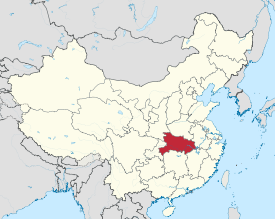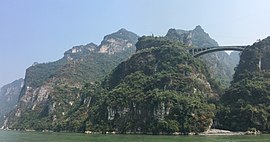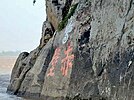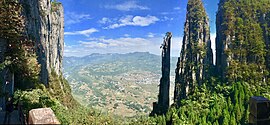
Back Hubei ACE Hubei Afrikaans Hubei ALS خوبي Arabic هوبيى ARZ Hubei AST Hubey Azerbaijani Хубэй Byelorussian Хубей Bulgarian হুপেই Bengali/Bangla
You can help expand this article with text translated from the corresponding article in Chinese. (June 2021) Click [show] for important translation instructions.
|
Hubei
湖北 | |
|---|---|
| Province of Hubei | |
| Name transcription(s) | |
| • Chinese | 湖北省 (Húběi Shěng) |
| • Abbreviation | HB / 鄂 (pinyin: È) |
(clockwise from top)
| |
 Map showing the location of Hubei Province | |
| Coordinates: 31°12′N 112°18′E / 31.2°N 112.3°E | |
| Country | China |
| Named for | 湖 hú—"lake" 北 běi—"north" "north of the (Dongting) Lake" |
| Capital (and largest city) | Wuhan |
| Divisions | 13 prefectures, 102 counties, 1235 townships |
| Government | |
| • Type | Province |
| • Body | Hubei Provincial People's Congress |
| • CCP Secretary | Wang Menghui |
| • Congress director | Wang Menghui |
| • Governor | Wang Zhonglin |
| • CPPCC chairman | Sun Wei |
| Area | |
| • Total | 185,900 km2 (71,800 sq mi) |
| • Rank | 13th |
| Highest elevation | 3,105 m (10,187 ft) |
| Population (2021)[3] | |
| • Total | 58,300,000 |
| • Rank | 10th |
| • Density | 310/km2 (810/sq mi) |
| • Rank | 12th |
| Demographics | |
| • Ethnic composition | Han: 95.6% Tujia: 3.7% Miao: 0.4% |
| • Languages and dialects | Southwestern Mandarin, Jianghuai Mandarin, Gan, Xiang |
| GDP[4] | |
| • Total | CN¥ 5.274 trillion US$ 784.1 billion |
| • Per capita | CN¥ 92,059 US$ 13,686 |
| ISO 3166 code | CN-HB |
| HDI (2021) | 0.775[5] (high) (9th) |
| Website | Hubei.gov.cn (Simplified Chinese) |
| Hubei | |||||||||||||||||||||||||||||||||||||||||||||
|---|---|---|---|---|---|---|---|---|---|---|---|---|---|---|---|---|---|---|---|---|---|---|---|---|---|---|---|---|---|---|---|---|---|---|---|---|---|---|---|---|---|---|---|---|---|
 "Hubei" in Chinese characters | |||||||||||||||||||||||||||||||||||||||||||||
| Chinese | 湖北 | ||||||||||||||||||||||||||||||||||||||||||||
| Postal | Hupeh | ||||||||||||||||||||||||||||||||||||||||||||
| Literal meaning | "North of the (Dongting) Lake" | ||||||||||||||||||||||||||||||||||||||||||||
| |||||||||||||||||||||||||||||||||||||||||||||
Hubei[a] is an inland province of China, and is part of the Central China region. The name of the province means "north of the lake", referring to its position north of Dongting Lake.[7] The provincial capital, Wuhan, serves as a major transportation hub and the political, cultural, and economic hub of central China.
Hubei's name is officially abbreviated to "鄂" (È), an ancient name associated with the eastern part of the province since the State of E of the Western Zhou dynasty of c. 1045–771 BCE; a popular name for Hubei is "楚" (Chǔ) (suggested by that of the powerful State of Chu, which existed in the area during the Eastern Zhou dynasty of 770 – 256 BCE). Hubei borders the provinces of Henan to the north, Anhui to the east, Jiangxi to the southeast, Hunan to the south, Chongqing to the west, and Shaanxi to the northwest. The high-profile Three Gorges Dam is located at Yichang, in the west of the province.
Hubei is the 7th-largest provincial economy of China, the second largest in the Central China region, the third largest in the South Central China region and the third largest among inland provinces. As of 2021[update], Hubei's nominal GDP was US$787 billion (CNY 5 trillion) and its GDP (nominal) per capita exceeded US$13,000, making it the richest landlocked province, the richest province in the Central China region, and 2nd richest province in South Central China region after Guangdong.[8]
- ^ "Hubei--Survey". Ministry Of Commerce - People's Republic Of China. 25 April 2007. Archived from the original on 6 April 2018. Retrieved 8 April 2018.
Hubei {...} an area of 185,900 square km.
- ^ 湖北 [Hubei] (in Chinese). The Central People's Government of the People's Republic of China. 26 March 2013. Archived from the original on 8 July 2016. Retrieved 7 June 2016.
全省国土总面积18.59万平方公里
- ^ "Communiqué of the Seventh National Population Census (No. 3)". National Bureau of Statistics of China. 11 May 2021. Retrieved 11 May 2021.
- ^ "National Data". National Bureau of Statistics of China. 1 March 2022. Retrieved 23 March 2022.
- ^ "Sub-national HDI - Subnational HDI - Global Data Lab". globaldatalab.org. Retrieved 2024-01-30.
- ^ "Hubei". Lexico UK English Dictionary. Oxford University Press. Archived from the original on May 18, 2021.
- ^ (in Chinese) Origin of the Names of China's Provinces Archived 2016-04-27 at the Wayback Machine, People's Daily Online.
- ^ "Decoding China's 2021 GDP Growth Rate: A Look at Regional Numbers". China Briefing News. 2022-02-07. Retrieved 2022-09-15.
Cite error: There are <ref group=lower-alpha> tags or {{efn}} templates on this page, but the references will not show without a {{reflist|group=lower-alpha}} template or {{notelist}} template (see the help page).
© MMXXIII Rich X Search. We shall prevail. All rights reserved. Rich X Search





